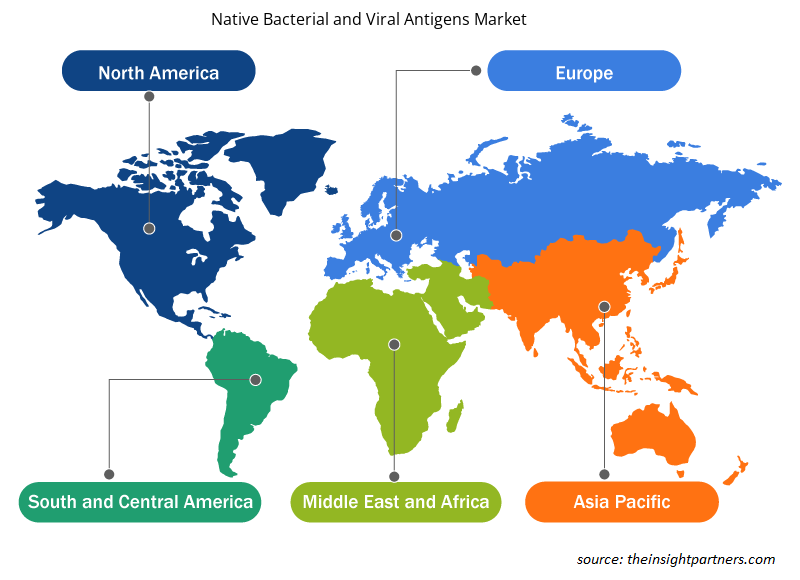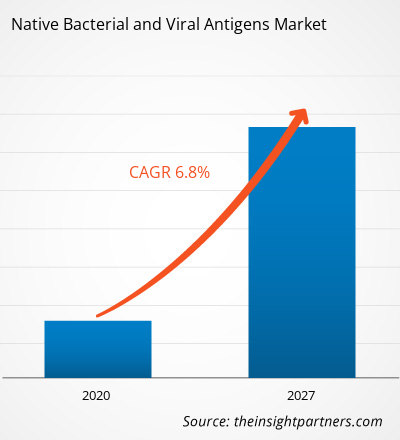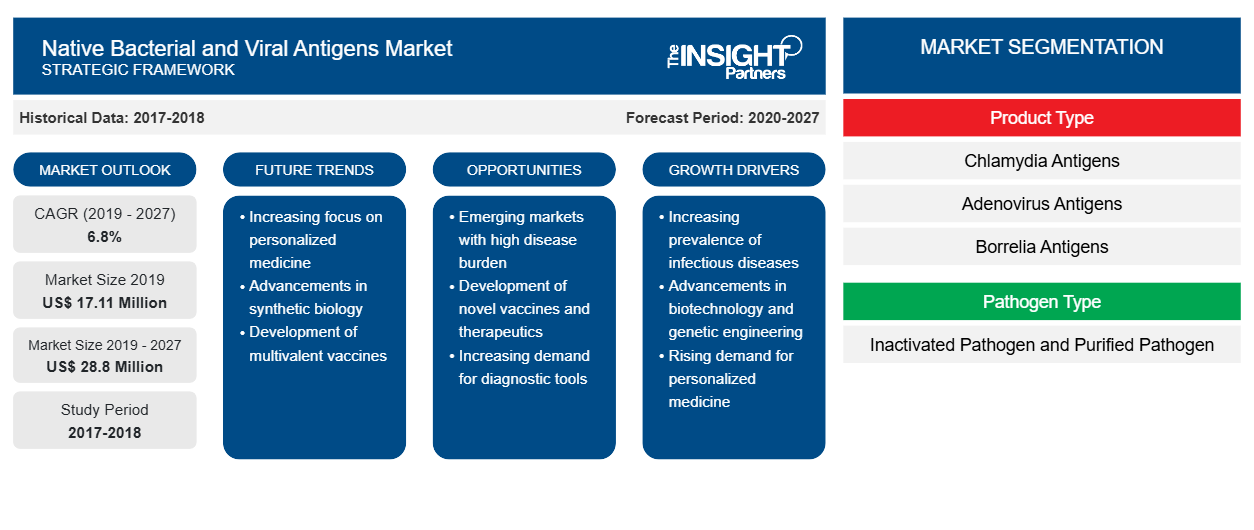Der Markt für native bakterielle und virale Antigene soll von 17.105.050 US-Dollar im Jahr 2019 auf 28.801.150 US-Dollar im Jahr 2027 anwachsen; von 2020 bis 2027 wird mit einer durchschnittlichen jährlichen Wachstumsrate von 6,8 % gerechnet.
Native Antigene werden in ihrer natürlichen Form aus den jeweiligen Quellen extrahiert. Da sie in vivo die üblichen Modifikationen durchlaufen, weisen sie bei der Isolierung eine große Ähnlichkeit mit der komplexen dreidimensionalen Struktur auf, die sie im Wirt aufweisen. Im Fall von Proteinantigenen können diese Modifikationen posttranslationale Veränderungen wie die Spaltung von Vorläuferproteinen, die Bildung von Disulfidbrücken und die Hinzufügung von Gruppen mit niedrigem Molekulargewicht durch Prozesse wie Glykosylierung oder Phosphorylierung umfassen. Der globale Markt für native bakterielle und virale Antigene wird von Faktoren wie der zunehmenden Verwendung nativer mikrobieller Antigene in der Diagnostik und Therapie sowie der steigenden Prävalenz von Infektionskrankheiten angetrieben. Die mit nativen Antigenen verbundenen Einschränkungen wie hohe Kosten, niedrige Antigenproduktionsniveaus und Schwierigkeiten bei der Skalierung hemmen jedoch das Marktwachstum. Schwellenmärkte schaffen jedoch Wachstumschancen für die Marktteilnehmer.
Passen Sie diesen Bericht Ihren Anforderungen an
Sie erhalten kostenlos individuelle Anpassungen an jedem Bericht, einschließlich Teilen dieses Berichts oder einer Analyse auf Länderebene, eines Excel-Datenpakets sowie tolle Angebote und Rabatte für Start-ups und Universitäten.
-
Holen Sie sich die wichtigsten Markttrends aus diesem Bericht.Dieses KOSTENLOSE Beispiel umfasst eine Datenanalyse von Markttrends bis hin zu Schätzungen und Prognosen.
Markteinblicke
Zunehmender Einsatz nativer mikrobieller Antigene in der Diagnostik und Therapie
Antigene sind Biomoleküle, die durch die Aktivierung von Lymphozyten eine Immunreaktion im Wirtskörper auslösen können. Bakterielle Antigene werden in Forschungslabors zur Entwicklung verschiedener Arten von Antikörpern zur Verbesserung des Immunsystems verwendet. Darüber hinaus werden bakterielle Antigene auch häufig in immundiagnostischen Tests wie ELISA verwendet.
Das Panning nativer Antigenbibliotheken hat zur Entwicklung wirksamer Neutralisierungsantikörper gegen verschiedene bakterielle und virale Infektionen geführt. Die nativen Antigene werden in ihrer natürlichen Form aus einer entsprechenden Quelle extrahiert. Es besteht eine hohe Nachfrage nach einer großen Anzahl nativer Antigene, insbesondere in der In-vitro-Diagnostik und der Impfstoffforschung. Laut verschiedenen wissenschaftlichen Studien weisen rekombinante Antigene Probleme mit der Löslichkeit und Aggregation auf. Darüber hinaus ist die Assoziation rekombinanter Antigene mit nicht-proteinhaltigen Einheiten anders und manchmal leistungsschwächer als bei nativen Antigenen.
Angesichts des jüngsten Ausbruchs von COVID-19 entwickeln Unternehmen kommerzielle SARS-CoV-2-Antigene zur Unterstützung der Impfstoffformulierung sowie zur Verbesserung der Diagnose und Therapie der Krankheit. Im Februar 2020 war die Native Antigen Company das erste Unternehmen, das die neuen Coronavirus-Antigene kommerziell anbot und dabei das firmeneigene VirtuE-Expressionssystem (HEK293) verwendete. Die zunehmende Verwendung nativer Antigene, die die Diagnostik und Therapie verschiedener Erkrankungen wirksam unterstützen, fördert somit das Wachstum des Marktes für native bakterielle Antigene und Antikörper.
Produkttypbasierte Einblicke
Der Markt für native bakterielle und virale Antigene ist je nach Produkttyp in Chlamydien-Antigene, Adenovirus-Antigene, Borrelien-Antigene, Clostridium-Antigene, Chikungunya-Virus-Antigene und Dengue-Virus-Antigene unterteilt. Das Segment Chlamydien-Antigene hatte 2019 den größten Marktanteil, und es wird erwartet, dass der Markt für dieses Segment im Prognosezeitraum mit der höchsten durchschnittlichen jährlichen Wachstumsrate wächst. Das Wachstum des Marktes für dieses Segment ist auf die leichte Verfügbarkeit dieser Antigene zurückzuführen, wobei die Mehrheit der Marktteilnehmer diese Antigene kommerziell in nativer Form anbietet. Darüber hinaus wird erwartet, dass die Verwendung von Chlamydien-Antigenen in Forschungsinstituten und Laboren zur Entwicklung von Impfstoffen und In-vitro-Diagnostiktests (IVD) das Wachstum des Marktes für dieses Segment weiter vorantreiben wird.
Erkenntnisse auf Basis des Erregertyps
Basierend auf dem Erregertyp ist der Markt für native bakterielle und virale Antigene in inaktivierte Erreger und gereinigte Erreger unterteilt. Das Segment der inaktivierten Erreger hatte 2019 einen größeren Marktanteil und wird im Prognosezeitraum voraussichtlich eine höhere durchschnittliche jährliche Wachstumsrate verzeichnen.
Anwendungsbasierte Erkenntnisse
Basierend auf der Anwendung ist der Markt für native bakterielle und virale Antigene in ELISA, Immunoassay, SDS-PAGE, Hämagglutination und Agglutinationstests unterteilt. Das ELISA-Segment hatte 2019 den größten Marktanteil und wird voraussichtlich zwischen 2020 und 2027 die höchste durchschnittliche jährliche Wachstumsrate verzeichnen.
Endbenutzerbasierte Erkenntnisse
Basierend auf dem Endverbraucher ist der Markt für native bakterielle und virale Antigene in diagnostische Labore und Zentren sowie akademische und Forschungsinstitute unterteilt. Das Segment der diagnostischen Labore und Zentren hatte 2019 den größten Marktanteil und wird voraussichtlich von 2020 bis 2027 die höchste durchschnittliche jährliche Wachstumsrate verzeichnen.
Produkteinführungen und Zulassungen sind die von Unternehmen am häufigsten angewandten Strategien, um ihre globale Präsenz und ihr Produktportfolio zu erweitern. Diese Strategien helfen ihnen, die wachsende Verbrauchernachfrage zu erfüllen. Zusammenarbeit ist eine der wichtigsten Strategien der auf dem Markt für native bakterielle und virale Antigene tätigen Unternehmen, um ihren Kundenstamm weltweit zu vergrößern und ihren Markennamen weltweit zu behaupten.
Regionale Einblicke in den Markt für native bakterielle und virale Antigene
Die regionalen Trends und Faktoren, die den Markt für native bakterielle und virale Antigene während des gesamten Prognosezeitraums beeinflussen, wurden von den Analysten von Insight Partners ausführlich erläutert. In diesem Abschnitt werden auch die Marktsegmente und die Geografie für native bakterielle und virale Antigene in Nordamerika, Europa, im asiatisch-pazifischen Raum, im Nahen Osten und Afrika sowie in Süd- und Mittelamerika erörtert.

- Erhalten Sie regionalspezifische Daten zum Markt für native bakterielle und virale Antigene
Umfang des Marktberichts über native bakterielle und virale Antigene
| Berichtsattribut | Details |
|---|---|
| Marktgröße im Jahr 2019 | 17,11 Millionen US-Dollar |
| Marktgröße bis 2027 | 28,8 Millionen US-Dollar |
| Globale CAGR (2019 - 2027) | 6,8 % |
| Historische Daten | 2017-2018 |
| Prognosezeitraum | 2020–2027 |
| Abgedeckte Segmente |
Nach Produkttyp
|
| Abgedeckte Regionen und Länder |
Nordamerika
|
| Marktführer und wichtige Unternehmensprofile |
|
Dichte der Marktteilnehmer für native bakterielle und virale Antigene: Auswirkungen auf die Geschäftsdynamik verstehen
Der Markt für native bakterielle und virale Antigene wächst rasant, angetrieben durch die steigende Nachfrage der Endnutzer aufgrund von Faktoren wie sich entwickelnden Verbraucherpräferenzen, technologischen Fortschritten und einem größeren Bewusstsein für die Vorteile des Produkts. Mit steigender Nachfrage erweitern Unternehmen ihr Angebot, entwickeln Innovationen, um die Bedürfnisse der Verbraucher zu erfüllen, und nutzen neue Trends, was das Marktwachstum weiter ankurbelt.
Die Marktteilnehmerdichte bezieht sich auf die Verteilung der Firmen oder Unternehmen, die in einem bestimmten Markt oder einer bestimmten Branche tätig sind. Sie gibt an, wie viele Wettbewerber (Marktteilnehmer) in einem bestimmten Marktraum im Verhältnis zu seiner Größe oder seinem gesamten Marktwert präsent sind.
Die wichtigsten auf dem Markt für native bakterielle und virale Antigene tätigen Unternehmen sind:
- BIO-RAD LABORATORIES INC.
- Microbix Biosystems
- SERION Immunologika
- Aalto Bio Reagents Ltd
- Enzo Life Sciences Inc.
Haftungsausschluss : Die oben aufgeführten Unternehmen sind nicht in einer bestimmten Reihenfolge aufgeführt.

- Erhalten Sie einen Überblick über die wichtigsten Akteure auf dem Markt für native bakterielle und virale Antigene
Markt für native bakterielle und virale Antigene – nach Produkttyp
- Chlamydien-Antigene
- Adenovirus-Antigene
- Borrelia-Antigene
- Chikungunya-Virus-Antigene
- Clostridium-Antigene
- Dengue-Virus-Antigene
Markt für native bakterielle und virale Antigene – nach Erregertyp
- Inaktivierter Erreger
- Gereinigter Erreger
Markt für native bakterielle und virale Antigene – nach Anwendung
- ELISA
- Immunassay
- SDS-SEITE
- Hämagglutination
- Agglutinationstest
Markt für native bakterielle und virale Antigene – nach Endbenutzer
- Diagnostische Labore und Zentren
- Akademische und Forschungsinstitute
Markt für native bakterielle und virale Antigene – nach Geografie
-
Nordamerika
- UNS
- Kanada
- Mexiko
-
Europa
- Frankreich
- Deutschland
- Italien
- Vereinigtes Königreich
- Spanien
- Restliches Europa
-
Asien-Pazifik (APAC)
- China
- Indien
- Südkorea
- Japan
- Australien
- Restlicher Asien-Pazifik-Raum
-
Naher Osten und Afrika (MEA)
- Südafrika
- Saudi-Arabien
- Vereinigte Arabische Emirate
- Restlicher Naher Osten und Afrika
-
Süd- und Mittelamerika
- Brasilien
- Argentinien
- Restliches Südamerika
Firmenprofile
- BIO-RAD LABORATORIES INC.
- Microbix Biosystems
- SERION Immunologika
- Aalto Bio Reagents Ltd
- Enzo Life Sciences Inc.
- Jena Bioscience GmbH
- ROSS SOUTHERN LABORATORIES
- Die Native Antigen Company
- Kreative Diagnostik
- TRINA BIOREACTIVES AG
- Historische Analyse (2 Jahre), Basisjahr, Prognose (7 Jahre) mit CAGR
- PEST- und SWOT-Analyse
- Marktgröße Wert/Volumen – Global, Regional, Land
- Branchen- und Wettbewerbslandschaft
- Excel-Datensatz
Aktuelle Berichte
Erfahrungsberichte
Grund zum Kauf
- Fundierte Entscheidungsfindung
- Marktdynamik verstehen
- Wettbewerbsanalyse
- Kundeneinblicke
- Marktprognosen
- Risikominimierung
- Strategische Planung
- Investitionsbegründung
- Identifizierung neuer Märkte
- Verbesserung von Marketingstrategien
- Steigerung der Betriebseffizienz
- Anpassung an regulatorische Trends























 Kostenlose Probe anfordern für - Markt für native bakterielle und virale Antigene
Kostenlose Probe anfordern für - Markt für native bakterielle und virale Antigene